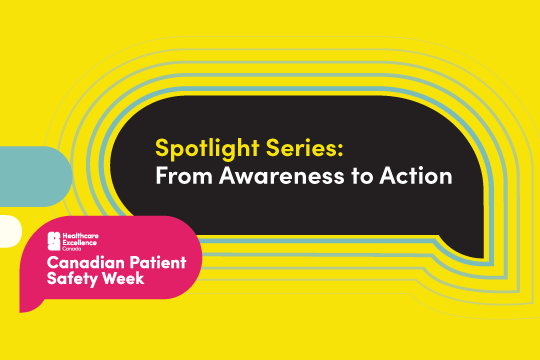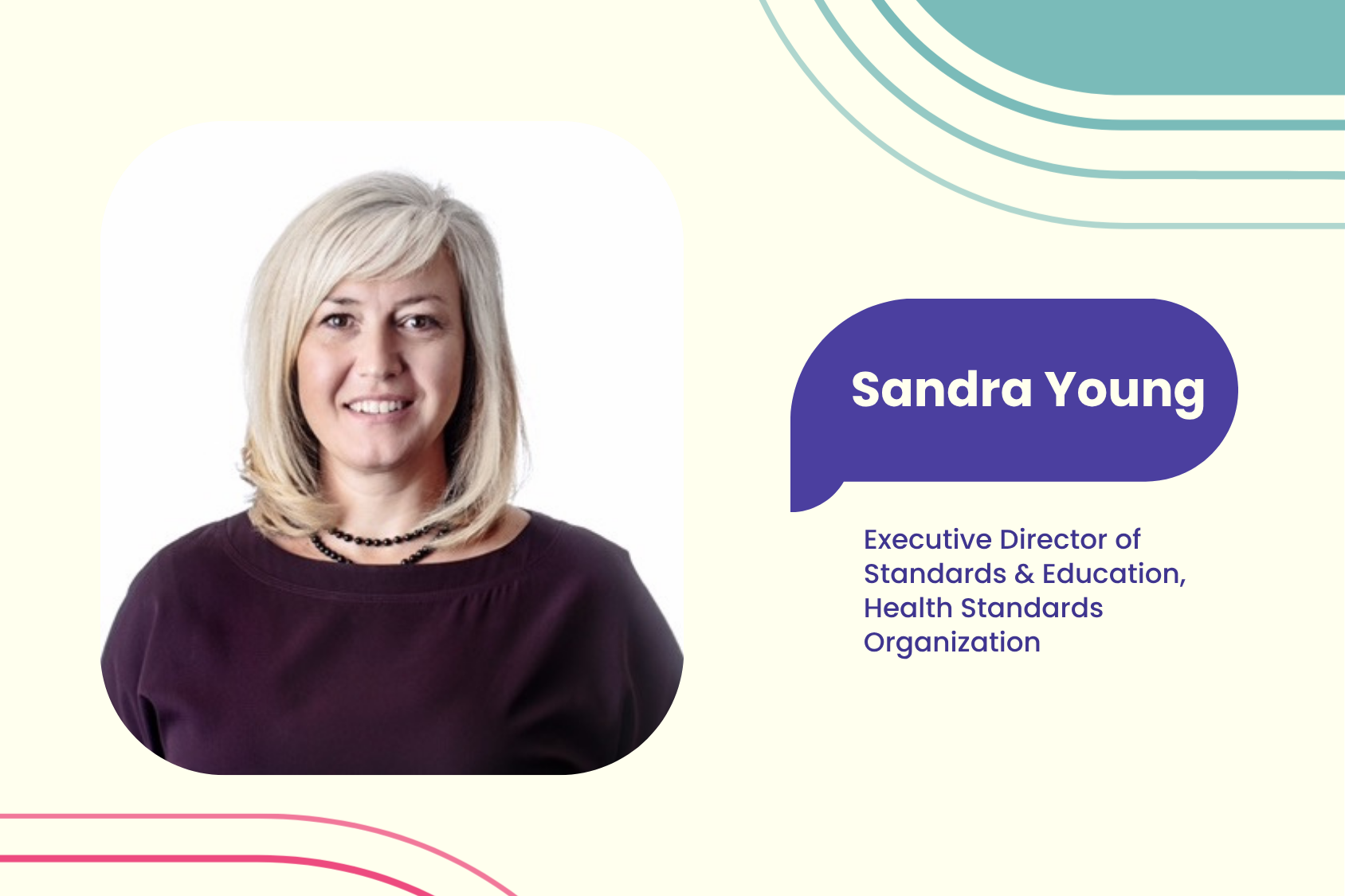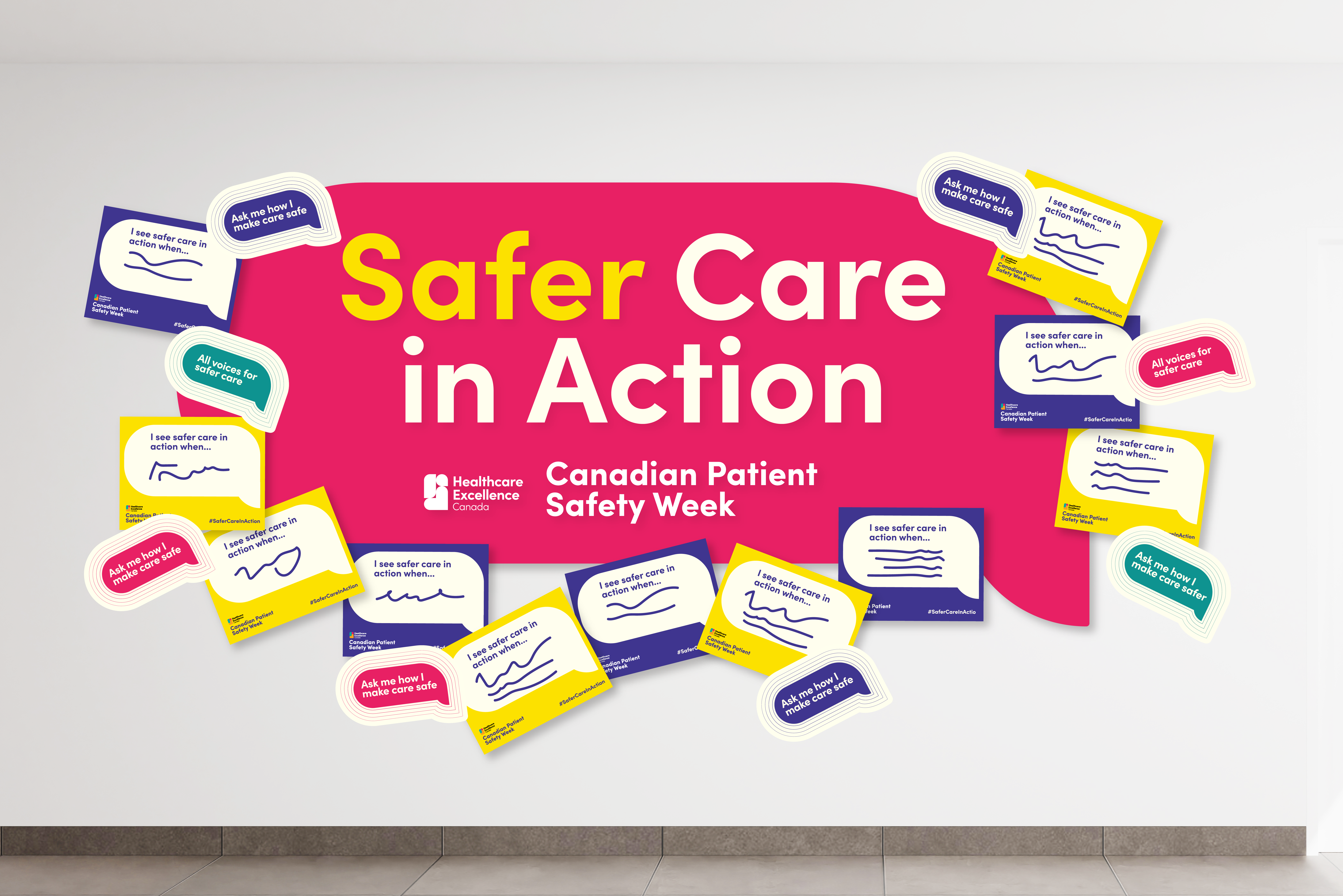

Canadian Patient Safety Week (CPSW) is an annual campaign that brings people together around a shared goal: making healthcare safer for everyone.
Be the first to know about CPSW 2026!
Thank you for joining us for CPSW 2025
CPSW 2025 has come to a close and we are thrilled to have seen so many people across Canada take action to make care safer for everyone.
This year’s theme, All Voices for Safer Care, was an invitation to listen more deeply, ask important questions, and take meaningful action – together.
During CPSW, we were inspired to see people across Canada:
- Celebrating big and small actions that make care safer through Safer Care in Action.
- Exploring how safety is shaped not only by systems and policies but by the voices of those who deliver, receive and support care through the CPSW Spotlight Series.
- Finding out what’s possible when we learn from one another and take action together through the All Voices for Safer Care blog series.
We were also inspired to see the creative ways people celebrated CPSW in their own settings, from coast to coast to coast.
CPSW 2025 may be over, but the momentum doesn’t end here. We invite you to continue to share how people across Canada are making care safer through Safer Care in Action. And those looking for support to make care safer can apply to join the Leading Safety Differently action series.
Thank you for taking action to help make care safer for everyone!
Related opportunity: Join the Leading Safety Differently action series
CPSW 2025 highlighted how everyone contributes to patient safety. Want to take it a step further? Join us for a four-month action series designed to support you with peer-to-peer learning, mentorship and expert coaching, and practical tools to help you create meaningful change.

From Awareness to Action: Beyond Harm, Toward Safer Care (English-first)
October 28, 2025

From Awareness to Action: Beyond Harm, Toward Safer Care (French-first)
October 30, 2025
All Voices for Safer Care Blog Series
Building safer healthcare systems isn’t the responsibility of one person or one role – it's something we create together. Throughout this blog series, we’re sharing the stories of champions for safer care who are helping redefine what safer care looks like in their communities and settings: from point of care to leadership, from lived experience to learning systems.

Closing the Safety Gap: Improving Children’s Pain Management Across Canada
At the heart of safer care is the belief that everyone deserves to be heard and supported — especially children. When children visit the hospital, families trust that they will receive the best available care that treats their child’s illness and manages their pain. But too often, children’s pain is missed or minimized, presenting a safety gap that comes with serious, lasting consequences.

Beyond Compliance: Sandra Young on How Standards, Collaboration, and Curiosity Drive Safer Care
All Voices for Safer Care reminds us that safer health care is not created by a single person or organization — it’s built together. By elevating every voice, from patients and caregivers to providers and system leaders, we can create the trust, curiosity and collaboration needed for meaningful change.

From Silence to Safer Care: Dignity and Inclusion for 2SLGBTQIA+ Older Adults
Some wounds never show on the surface. They live quietly in the way a person lowers their voice or glances around before speaking their truth.
Darren Usher has dedicated himself to tending those invisible injuries, the ones left by decades of being silenced, shamed, and forgotten.

From Hospital Hallways to Safer Spaces: Providing Comfort and Promoting Dignity for People Experiencing Homelessness
Many palliative care models don’t meet the needs of people experiencing homelessness or housing insecurity, where barriers to diagnosis and treatment often turn preventable conditions into life-threatening ones.

Rebuilding trust: Martin Beaumont’s journey of reconciliation
Sometimes an event doesn’t just disrupt a system. It changes how we see it, and we cannot forget. For Martin Beaumont, President and CEO of CHU de Québec – Université Laval and a board member of Healthcare Excellence Canada, the death of Joyce Echaquan was such a moment.

All Voices, Lasting Impact: Sparking Change for Safer Long-Term Care
As the healthcare system across the country continues to face pressing challenges such as staff shortages and administrative burden, leaders and healthcare teams are often left with limited resources to devote to quality improvement and safety initiatives.

Protecting mothers, babies and traditions: Delivering safer care through midwifery
Kenhtè:ke Midwives serves all interested First Nations, Inuit and Métis families on Tyendinaga Mohawk Territory and surrounding areas, providing full-scope midwifery care grounded in cultural traditions and community connection.

What lived experience teaches care: The journey of Vincent Dumez
“I am first and foremost a patient. An old patient.”
This is how Vincent Dumez introduces himself, even after a life devoted to championing causes, sharing lived wisdom and shouldering many responsibilities.

Celebrating Everyday Safety Acts
Recognize, share and celebrate actions that make care safer with everyone involved in delivering or receiving care.
Bring All Voices to Safer Care to life in your setting
Download and share these resources to spark conversation, inspire action and highlight what safer care means to your teams and community.
Celebrating Everyday Safety Acts activity card
This activity card invites everyone involved in delivering or receiving care to recognize, share and celebrate actions that make care safer.
“I see safer care in action when…” cards
Print and cut out these cards to highlight how people see safer care in action in your setting.
Size: 8.5 x 11 inches
I see safer care in action when…
“Patients feel they are part of the care rather than care happening to them.”
- Allied Healthcare Provider (Ontario)

“Patients feel they are part of the care rather than care happening to them.”
- Allied Healthcare Provider (Ontario)

“Patients, families, and care teams work together in partnership – when voices are heard, communication is clear, and decisions are made with compassion and respect. It’s in the small moments of listening, the transparency of shared information, and the courage to speak up that trust is built and safety thrives.”
- Patient Advisor (Ontario)

“Patients, families, and care teams work together in partnership – when voices are heard, communication is clear, and decisions are made with compassion and respect. It’s in the small moments of listening, the transparency of shared information, and the courage to speak up that trust is built and safety thrives.”
- Patient Advisor (Ontario)

“Everyone feels safe to ask questions.”
- Administrator (Manitoba)

“Everyone feels safe to ask questions.”
- Administrator (Manitoba)

“Care providers acknowledge and address systemic barriers, tailor services to meet the cultural and historical realities of different communities and create space for community voices in decision-making.”
- Consultant (Nova Scotia)

“Care providers acknowledge and address systemic barriers, tailor services to meet the cultural and historical realities of different communities and create space for community voices in decision-making.”
- Practical Nursing Student (British Columbia)

“When we actively listen to the needs and concerns of patients and families.”
- Administrator (Prince Edward Island)

“When we actively listen to the needs and concerns of patients and families.”
- Administrator (Prince Edward Island)

“Everyone has a voice.”
- Quality Improvement Lead (Manitoba)

“Everyone has a voice.”
- Quality Improvement Lead (Manitoba)

“I am informed of each step of my care, when I am seen and heard as an expert in my care, when staff see me as more than a burden to the system as a person living with complex care needs.”
- Patient Advisor (Saskatchewan)

“I am informed of each step of my care, when I am seen and heard as an expert in my care, when staff see me as more than a burden to the system as a person living with complex care needs.”
- Patient Advisor (Saskatchewan)

“I see staff taking extra time and educating patients and their families and caregivers on what to expect during their visit and after their visit and really taking the time to ensure they understand their care plan. I see safer care in action when I see a patient's emotional wellbeing considered in their care plan not just their physical or health condition.”
- Clinical Safety Coordinator (Alberta)

“I see staff taking extra time and educating patients and their families and caregivers on what to expect during their visit and after their visit and really taking the time to ensure they understand their care plan. I see safer care in action when I see a patient's emotional wellbeing considered in their care plan not just their physical or health condition.”
- Clinical Safety Coordinator (Alberta)


Improving care for one million with Care Forward
A growing pan-Canadian movement transforming care for over a million people by advancing healthcare quality and safety.

Improving care for one million with Care Forward
A growing pan-Canadian movement transforming care for over a million people by advancing healthcare quality and safety.


